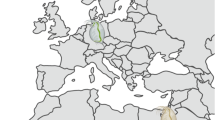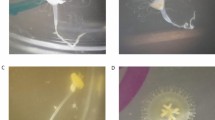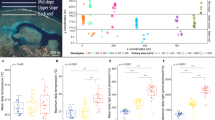Abstract
Host-associated microbiota vary across host individuals and environmental conditions, but the relative importance of their genetic background versus their environment is difficult to disentangle. We sought to experimentally determine the factors shaping the microbiota of the planktonic Crustacean, Daphnia magna. We used clonal lines from a wide geographic distribution, which had been kept under standardized conditions for over 75 generations. Replicate populations were kept for three generations at 20 and 28 °C. The interaction of the host clonal line and environment (i.e., temperature) influenced microbiota community characteristics, including structure, the relative abundance of common microbial species, and the microbial richness and phylogenetic diversity. We did not find any correlation between host-associated microbiota and the geographic origin of the clones or their temperature tolerance. Our results highlight the prominent effects that host clonal lineage and its interaction with the environment has on host-associated microbiota composition.




Similar content being viewed by others
References
Fan L, Liu M, Simister R, Webster NS, Thomas T (2013) Marine microbial symbiosis heats up: the phylogenetic and functional response of a sponge holobiont to thermal stress. ISME J 7:991–1002. https://doi.org/10.1038/ismej.2012.165
Seedorf H, Griffin NW, Ridaura VK, Reyes A, Cheng J, Rey FE, Smith MI, Simon GM, Scheffrahn RH, Woebken D, Spormann AM, Van Treuren W, Ursell LK, Pirrung M, Robbins-Pianka A, Cantarel BL, Lombard V, Henrissat B, Knight R, Gordon JI (2014) Bacteria from diverse habitats colonize and compete in the mouse gut. Cell 159:253–266. https://doi.org/10.1016/j.cell.2014.09.008
Franzenburg S, Fraune S, Künzel S, Baines JF, Domazet-Loso T, Bosch TCG (2012) MyD88-deficient hydra reveal an ancient function of TLR signaling in sensing bacterial colonizers. Proc Natl Acad Sci U S A 109:19374–19379. https://doi.org/10.1073/pnas.1213110109
Garrett WS, Gordon JI, Glimcher LH (2010) Homeostasis and inflammation in the intestine. Cell 140:859–870. https://doi.org/10.1016/j.cell.2010.01.023
Benson AK, Kelly SA, Legge R, Ma F, Low SJ, Kim J, Zhang M, PL O, Nehrenberg D, Hua K, Kachman SD, Moriyama EN, Walter J, Peterson DA, Pomp D (2010) Individuality in gut microbiota composition is a complex polygenic trait shaped by multiple environmental and host genetic factors. Proc Natl Acad Sci U S A 107:18933–18938. https://doi.org/10.1073/pnas.1007028107
Campbell JH, Foster CM, Vishnivetskaya T, Campbell AG, Yang ZK, Wymore A, Palumbo AV, Chesler EJ, Podar M (2012) Host genetic and environmental effects on mouse intestinal microbiota. ISME J 6:2033–2044. https://doi.org/10.1038/ismej.2012.54
Wilkins LGE, Fumagalli L, Wedekind C (2016) Effects of host genetics and environment on egg-associated microbiotas in brown trout (Salmo trutta). Mol Ecol. 25:4930–4945. https://doi.org/10.1111/mec.13798
Benson AK, Kelly SA, Legge R, Ma F, Low SJ, Kim J, Zhang M, PL O, Nehrenberg D, Hua K, Kachman SD, Moriyama EN, Walter J, Peterson DA, Pomp D (2010) Individuality in gut microbiota composition is a complex polygenic trait shaped by multiple environmental and host genetic factors. Proc Natl Acad Sci 107:18933–18938. https://doi.org/10.1073/pnas.1007028107
Stuart YE, Veen T, Weber JN, Hanson D, Ravinet M, Lohman BK, Thompson CJ, Tasneem T, Doggett A, Izen R, Ahmed N, Barrett RDH, Hendry AP, Peichel CL, Bolnick DI (2017) mao rta aq nabasahan imo man mesenger g.gamitContrasting effects of environment and genetics generate a continuum of parallel evolution. Nat Ecol Evol 1:158. https://doi.org/10.1038/s41559-017-0158
Pigliucci M (2005) Evolution of phenotypic plasticity: where are we going now? Trends Ecol Evol 20:481–486. https://doi.org/10.1016/j.tree.2005.06.001
Moczek AP, Sultan S, Foster S, Ledón-Rettig C, Dworkin I, Nijhout HF, Abouheif E, Pfennig DW (2011) The role of developmental plasticity in evolutionary innovation. Proc. R. Soc. B Biol. Sci. 278:2705–2713. https://doi.org/10.1098/rspb.2011.0971
Pfennig DW, Wund MA, Snell-Rood EC, Cruickshank T, Schlichting CD, Moczek AP (2010) Phenotypic plasticity's impacts on diversification and speciation. Trends Ecol Evol 25:459–467. https://doi.org/10.1016/j.tree.2010.05.006
David LA, Maurice CF, Carmody RN, Gootenberg DB, Button JE, Wolfe BE, Ling AV, Devlin aS, Varma Y, Fischbach MA, Biddinger SB, Dutton RJ, Turnbaugh PJ (2013) Diet rapidly and reproducibly alters the human gut microbiome. Nature 505:559–563. https://doi.org/10.1038/nature12820
Carmody RN, Gerber GK, Luevano JM, Gatti DM, Somes L, Svenson KL (2015) Diet dominates host genotype in shaping the murine gut microbiota. Cell Host Microbe 17:72–84. https://doi.org/10.1016/j.chom.2014.11.010
Schmidt VT, Smith KF, Melvin DW, Amaral-Zettler LA (2015) Community assembly of a euryhaline fish microbiome during salinity acclimation. Mol Ecol 24:2537–2550. https://doi.org/10.1111/mec.13177
Cariveau DP, Elijah Powell J, Koch H, Winfree R, Moran NA (2014) Variation in gut microbial communities and its association with pathogen infection in wild bumble bees (Bombus). ISME J 8:2369–2379. https://doi.org/10.1038/ismej.2014.68
Jani AJ, Briggs CJ (2014) The pathogen Batrachochytrium dendrobatidis disturbs the frog skin microbiome during a natural epidemic and experimental infection. Proc Natl Acad Sci U S A 111:E5049–E5058. https://doi.org/10.1073/pnas.1412752111
Parks BW, Nam E, Org E, Kostem E, Norheim F, Hui ST, Pan C, Civelek M, Rau CD, Bennett BJ, Mehrabian M, Ursell LK, He A, Castellani LW, Zinker B, Kirby M, Drake TA, Drevon CA, Knight R, Gargalovic P, Kirchgessner T, Eskin E, Lusis AJ (2013) Genetic control of obesity and gut microbiota composition in response to high-fat, high-sucrose diet in mice. Cell Metab 17:141–152. https://doi.org/10.1016/j.cmet.2012.12.007
Peerakietkhajorn S, Tsukada K, Kato Y, Matsuura T, Watanabe H (2015) Symbiotic bacteria contribute to increasing the population size of a freshwater crustacean, Daphnia magna. Environ Microbiol Rep 7:364–372. https://doi.org/10.1111/1758-2229.12260
Callens M, Macke E, Muylaert K, Bossier P, Lievens B, Waud M, Decaestecker E (2016) Food availability affects the strength of mutualistic host-microbiota interactions in Daphnia magna. ISME J 10:911–920. https://doi.org/10.1038/ismej.2015.166
Sison-Mangus MP, Mushegian AA, Ebert D (2015) Water fleas require microbiota for survival, growth and reproduction. ISME J 9:59–67. https://doi.org/10.1038/ismej.2014.116
Peerakietkhajorn S, Kato Y, Kasalický V, Matsuura T, Watanabe H (2015) Betaproteobacteria Limnohabitans strains increase fecundity in the crustacean Daphnia Magna: symbiotic relationship between major bacterioplankton and zooplankton in freshwater ecosystem. Environ Microbiol n/a-n/a. doi:https://doi.org/10.1111/1462-2920.12919
Mushegian AA, Burcklen E, Schär TMM, Ebert D (2016) Temperature-dependent benefits of bacterial exposure in embryonic development of Daphnia magna resting eggs. J Exp Biol 219:897–904. https://doi.org/10.1242/jeb.134759
Lokmer A, Wegner KM (2015) Hemolymph microbiome of Pacific oysters in response to temperature, temperature stress and infection. ISME J 9:670–682. https://doi.org/10.1038/ismej.2014.160
Prado SS, Hung KY, Daugherty MP, Almeida RPP (2010) Indirect effects of temperature on stink bug fitness, via maintenance of gut-associated symbionts. Appl Environ Microbiol 76:1261–1266. https://doi.org/10.1128/AEM.02034-09
Yampolsky L, Schaer T, Ebert D (2014) Adaptive phenotypic plasticity and local adaptation for temperature tolerance in freshwater zooplankton. Proc R Soc Biol Sci 281:20132744
Yampolsky LY, Zeng E, Lopez J, Williams PJ, Dick KB, Colbourne JK, Pfrender ME (2014) Functional genomics of acclimation and adaptation in response to thermal stress in Daphnia. BMC Genomics 15:859. https://doi.org/10.1186/1471-2164-15-859
Klüttgen B, Dulmer U, Engels M, Ratte HT (1994) ADaM, an artificial freshwater for the culture of zooplankton. Water Res 28. https://doi.org/10.1016/0043-1354(94)90157-0
Edgar RC, Haas BJ, Clemente JC, Quince C, Knight R (2011) UCHIME improves sensitivity and speed of chimera detection. Bioinformatics 27:2194–2200. https://doi.org/10.1093/bioinformatics/btr381
Edgar RC (2010) Search and clustering orders of magnitude faster than BLAST. Bioinformatics 26:2460–2461. https://doi.org/10.1093/bioinformatics/btq461
Altschul SF, Gish W, Miller W, Myers EW, Lipman DJ (1990) Basic local alignment search tool. J Mol Biol 215:403–410. https://doi.org/10.1016/s0022-2836(05)80360-2
McDonald D, Price MN, Goodrich J, Nawrocki EP, DeSantis TZ, Probst A, Andersen GL, Knight R, Hugenholtz P (2012) An improved Greengenes taxonomy with explicit ranks for ecological and evolutionary analyses of bacteria and archaea. ISME J 6:610–618. https://doi.org/10.1038/ismej.2011.139
Caporaso JG, Bittinger K, Bushman FD, DeSantis TZ, Andersen GL, Knight R (2010) PyNAST: a flexible tool for aligning sequences to a template alignment. Bioinformatics 26:266–267. https://doi.org/10.1093/bioinformatics/btp636
Stamatakis A (2014) RAxML version 8: a tool for phylogenetic analysis and post-analysis of large phylogenies. Bioinformatics 30:1312–1313. https://doi.org/10.1093/bioinformatics/btu033
Lozupone CA, Hamady M, Kelley ST, Knight R (2007) Quantitative and qualitative beta diversity measures lead to different insights into factors that structure microbial communities. Appl Environ Microbiol 73:1576–1585. https://doi.org/10.1128/AEM.01996-06
Caporaso JG, Kuczynski J, Stombaugh J, Bittinger K, Bushman FD, Costello EK, Fierer N, Peña AG, Goodrich JK, Gordon JI, Huttley GA, Kelley ST, Knights D, Koenig JE, Ley RE, Lozupone CA, Mcdonald D, Muegge BD, Pirrung M, Reeder J, Sevinsky JR, Turnbaugh PJ, Walters WA, Widmann J, Yatsunenko T, Zaneveld J, Knight R (2010) QIIME allows analysis of high-throughput community sequencing data. Nat Methods 7:335–336. https://doi.org/10.1038/nmeth0510-335
Oksanen J, Blanchet FG, Kindt R, Legendre P, Minchin PR, O'Hara RB, Simpson GL, Solymos P, Steven MHH, Wagner H (2015) Vegan: community ecology package. R package version 2.2–1. http://CRAN.R-project.org/package=vegan
R Core Team (2016) R: a language and environment for statistical computing. R Foundation for Statistical Computing V, Austria. URL https://http://www.R-project.org/
Love MI, Huber W, Anders S (2014) Moderated estimation of fold change and dispersion for RNA-seq data with DESeq2. Genome Biol 15:550. https://doi.org/10.1186/s13059-014-0550-8
Peres-Neto P, Jackson D (2001) How well do multivariate data sets match? The advantages of a procrustean superimposition approach over the mantel test. Oecologia 129:169–178. https://doi.org/10.1007/s004420100720
Freese HM, Schink B (2011) Composition and stability of the microbial community inside the digestive tract of the aquatic crustacean Daphnia magna. Microb Ecol 62:882–894. https://doi.org/10.1007/s00248-011-9886-8
Qi W, Nong G, Preston JF, Ben-Ami F, Ebert D (2009) Comparative metagenomics of Daphnia symbionts. BMC Genomics 10:172. https://doi.org/10.1186/1471-2164-10-172
Eckert EM, Pernthaler J (2014) Bacterial epibionts of Daphnia: a potential route for the transfer of dissolved organic carbon in freshwater food webs. ISME J 8:1808–1819. https://doi.org/10.1038/ismej.2014.39
Wilkins LGE, Rogivue A, Schütz F, Fumagalli L, Wedekind C (2015) Increased diversity of egg-associated bacteria on brown trout (Salmo trutta) at elevated temperatures. Sci Rep 5:17084. https://doi.org/10.1038/srep17084
Nishiguchi MK (2000) Temperature affects species distribution in symbiotic populations of Vibrio spp. Appl Environ Microbiol 66:3550–3555. https://doi.org/10.1128/AEM.66.8.3550-3555.2000.Updated
Webster NS, Cobb RE, Negri AP (2008) Temperature thresholds for bacterial symbiosis with a sponge. ISME J 2:830–842. https://doi.org/10.1038/ismej.2008.42
Fields PD, Reisser C, Dukić M, Haag CR, Ebert D (2015) Genes mirror geography in Daphnia Magna. Mol Ecol 24:4521–4536. https://doi.org/10.1111/mec.13324
Mushegian AA, Walser J-C, Sullam KE, Ebert D The microbiota of diapause: how host–microbe associations are formed after dormancy in an aquatic crustacean. J Anim Ecol In Press. doi:https://doi.org/10.1111/1365-2656.12709
Vannier N, Mony C, Bittebière A-K, Vandenkoornhuyse P (2015) Epigenetic mechanisms and microbiota as a toolbox for plant phenotypic adjustment to environment. Front Plant Sci 6:1159. https://doi.org/10.3389/fpls.2015.01159
Rook G, Bäckhed F, Levin BR, McFall-Ngai MJ, McLean AR (2017) Evolution, human-microbe interactions, and life history plasticity. Lancet 390:521–530. https://doi.org/10.1016/S0140-6736(17)30566-4
Acknowledgements
We thank Jürgen Hottinger, Elodie Burcklen, Marilou Sison-Mangus, Mahendra Mariadassou, Lev Yampolsky, and members of the Ebert Group at the Zoological Institute for assistance in the laboratory and helpful discussion and feedback. We also thank the anonymous reviewers for their comments on the manuscript.
Funding
This work was supported with grants from the European Research Council, the Swiss National Science, and the Forschungsfonds of the University of Basel.
Author information
Authors and Affiliations
Corresponding author
Electronic Supplementary Material
Rights and permissions
About this article
Cite this article
Sullam, K.E., Pichon, S., Schaer, T.M.M. et al. The Combined Effect of Temperature and Host Clonal Line on the Microbiota of a Planktonic Crustacean. Microb Ecol 76, 506–517 (2018). https://doi.org/10.1007/s00248-017-1126-4
Received:
Accepted:
Published:
Issue Date:
DOI: https://doi.org/10.1007/s00248-017-1126-4




